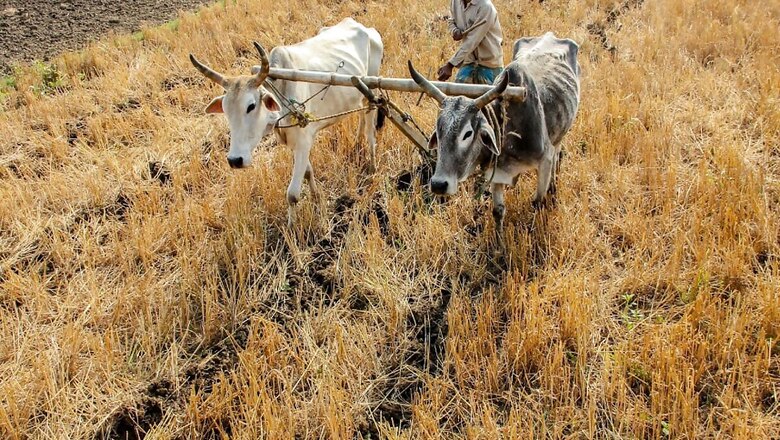
views
When it comes to agriculture, India is a land of contradictions.
Contradictions that affect the lives of the millions of farmers engaged in farming activity. They need a way out of this way of life that has affected them for so long. We have seen thousands of farmers committing suicide every year and have its official records since 1995 when the National Crime Records Bureau (NCRB) started publishing such data.
The farmers of this country desperately need farm reforms and the new farm laws introduced through the three farm bills are a step in the right direction if implemented well. India is one of the top producers of several crops in the world but when it comes to productivity parameters, i.e., crop produced per unit of land, we are yet laggards. This affects the most important chain of our food production system, i.e., farmers directly.
Their livelihood is linked to the production they have in their fields but they failed to increase their grain production to the needed scale. Most of them are poor farmers with small landholding sizes. They cannot invest in irrigation techniques in a country where seasonal rains through the monsoon fail regularly. They cannot invest in required agri-technology and scientific methods to increase their per unit crop yield.
Another contradiction is about the scale. Agriculture, once a sector that sustained the most number of people in the country, or the farmers, fails to achieve the required growth rate. In the 1950s, agriculture was the mainstay of the Indian economy, contributing more than 50% of the GDP. 70% of India’s workforce was engaged in agriculture. Cut to the current time. Agriculture, as a sector, has seen a massive decline. Its contribution to the GDP was around 17% in 2019-20.
But it still employs the maximum number of people in the country, over 55%, which raises many questions. Why this decline when the largest manpower resource of the country is still involved in the same sector that was once the mainstay of the Indian economy? Why it is so despite massive success of Green Revolution that has made India not only self-dependent but also a top-level exporter in agricultural crops?
As mentioned in the beginning, we have not been able to advance our agricultural yield and so to raise the comprehensive grain production output. Agricultural land in India has been fragmented gradually into smaller segments with increasing population over the years. As per the data compiled from the Agricultural Census 2011 and 2019, India had 36 million agricultural landholdings in 1971. It increased to over 100 million in 2016, over 68% of total holdings. 82% of India’s farmers are still marginal and small.
The result? The income level of farmers could not grow in the proportion required due to the reduced landholding sizes and they were unable to introduce advanced mechanisation and irrigation techniques. A factor that is a major cause of India’s low crop yield crisis.
India has the maximum arable land in the world, says a map analysis by the US Geological Survey. The map released in 2017 shows India has 179.8 million hectares of cropland, more than the USA’s 167.8 million hectares and China’s 165.2 million hectares. While South Asia is called the agricultural capital of the world, only around 20% of the country’s farmland is used for crop production in USA and China.
However, when it comes to the agricultural yield, or amount of crop produced per unit of land, we still lack the depth, advancement and sophistication other major crop producing countries have achieved. India, despite having the most arable land in the world, ranks behind USA and China in grain production. India’s food grain production target, mostly for wheat and rice, for 2020-21, is around 300 million tonnes, while for China it is around 350 million tonnes. The US produced around 430 million tonnes of grains in 2019-20.
As per the Food & Agricultural Organisation (FAO) 2014 data, India is well below the global average in crop and legume yield. India, on an average, produces 2,391 kg per hectare rice while the global average is 3,026 kg per hectare. The global average in wheat production is 3,289 kg per hectare while in India, it is 2,750 kg per hectare. We are much below in maize production with 2,632 kg per hectare while the global average is 5,664 ke per hectare.
India is the second largest producer of rice yet ranks behind USA, China and Brazil when it comes to agricultural yield. We are the second largest wheat producing country but behind China in crop yield. We are the largest producers of pulse yet are laggards in crop production and come fourth after USA, China and Brazil.
A factor that reflects a crisis the Indian farmer is in.
A poor, self-sustaining farmer cannot achieve the production finesse that farmers of economically advanced and less populated countries like USA achieve or, in case of China, a country that is more populated than India but where agricultural production has seen decades of farm reforms, covers a much larger irrigated area and introduction of agri-technology is quite well taken in.
So, what is the way out for the Indian farmer?
He needs collaboration to have better irrigation facilities and advanced farming techniques to increase his agricultural yield. He needs access to agri-technology. He needs to do the trade directly to gain more benefits. And he needs a system that can help him as financially the much needed requirements are beyond his limits.
Economically it may not be viable for the Government of India to support the large arable land it has to develop irrigation facilities for and introduce advanced crop production techniques, but it can rope in private players to fill the gap.
The new farm laws can be a much needed farm reform measure. The laws introduced through the bills allow contract farming where farmers can collaborate with agribusinesses directly. The laws enacted through these bills ensure that farmers will get a pre-decided fixed price coupled with other benefits like getting advanced tech and introduction to crop production fatalities and will be free from the clutches of middlemen who corner away a big chunk of farmer’s revenue.
New laws introduced ensure that the prospective collaborators cannot purchase farmers’ land and though there is no mention of the minimum support price (MSP), the government is now ready to give it in writing that the MSP system will continue after protests over the fear that MSP will be phased out.
The present farm laws are not going to remove the existing market system that is already in place. The laws are not going to remove the APMC mandis but are giving farmers a wider option here to interact directly with prospective buyers and it will directly help the marginal and small farmers once the contract farming structure is mainstreamed. Marginal and small farmers of an area can pool in their land and can bargain effectively from the prospective buyers. Agribusinesses, on the other hand, will ensure the introduction of latest agri-technology in their fields to gain more output on their investment. It can be a win-win situation for both, for farmers and agribusinesses, if implemented effectively.
Read all the Latest News, Breaking News and Coronavirus News here




















Comments
0 comment